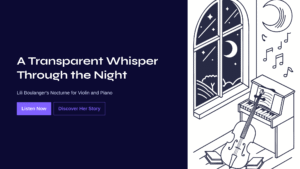Table of Contents

A Quiet Light That Settles in the Heart
Some music has the power to make time stand still. César Franck’s “Panis Angelicus” is precisely such a piece. From the moment its first notes unfold, they caress the deepest corners of our hearts like light filtering through cathedral stained glass windows.
This composition, whose Latin title means “Bread of Angels,” transcends the boundaries of simple sacred song to touch something profoundly pure within human emotion. Have you ever found yourself seeking a moment of quietude amidst the noise of daily life? If so, let this piece be your companion for a while.

1872: A Composer’s Devout Heart
César Franck (1822-1890), a Belgian-born French composer, left a distinctive mark on the French musical landscape of the late 19th century. He taught organ and composition at the Paris Conservatory, where his students remembered him as both a strict and warmly paternal figure.
“Panis Angelicus” was composed in 1872, when Franck was fifty years old, as part of a larger cantata work. This was shortly after the Franco-Prussian War had ended, a time when society was healing its wounds and searching for new hope. Against this historical backdrop, Franck expressed through music a longing for religious consolation and peace.
Originally intended as a sacred song for communion during Mass, the piece carries Latin text meaning “The bread of angels becomes the bread of mankind; the heavenly bread puts an end to all symbols.” Yet Franck infused this liturgical foundation with his distinctive Romantic harmonies and lyrical melodies, elevating it from simple ceremonial music to profound artistic expression.

Three Waves of Flowing Melody
The First Wave: A Gentle Beginning
The piece opens with soft orchestral harmonies, like morning mist slowly lifting to reveal the landscape beneath. Though cast in a minor key, the atmosphere breathes with warmth rather than darkness. When the soloist’s voice enters with “Panis angelicus,” it whispers like a prayer, humble and reverent.
Franck’s characteristic harmonic language shines here. The minor mode doesn’t feel heavy or somber, but rather glows with the gentle warmth of candlelight. This reflects Franck’s masterful reinterpretation of German Romantic harmonic vocabulary through a distinctly French lens of elegance and refinement.
The Second Wave: An Ascent of Hope
With “Fit panis hominum,” the melody begins its gradual ascent. The natural flow from low to high registers evokes the image of a prayer rising heavenward. The melodic arc feels inevitable yet surprising, like watching a bird take flight.
Then comes the magical moment of “Dat panis cœlicus,” where the harmony suddenly brightens with major-key colors. This harmonic shift is truly enchanting—like sunlight breaking through clouds, the entire musical landscape is bathed in warm, golden light. Here, Franck transcends mere religious devotion to sing of human comfort and hope.
The Third Wave: A Humble Return
The final “Figuris terminum” returns to the original minor key, but this homecoming carries a different depth than the opening. Like a traveler returning from a long journey, there’s a sense of peace and fulfillment, of having touched something greater than oneself.
The interplay between orchestra and voice creates harmonies that are simple yet profound. Franck employs Baroque contrapuntal techniques while maintaining the emotional directness of 19th-century Romanticism—a delicate balance that few composers could achieve with such grace.

Small Bells Ringing in My Heart
Each time I hear this piece, I’m transported to the small chapel I visited as a child, holding my grandmother’s hand. The quietude and warmth of that sacred space, along with a deep sense of gratitude for something unnamed, comes alive again in “Panis Angelicus.”
The greatest gift of Franck’s composition lies in its power to console. Regardless of one’s religious beliefs, this music connects us to something pure and essential within ourselves. It offers comfort like a mother’s lullaby or the gentle reassurance of an old friend.
The moment when the harmony shifts to major in the middle section never fails to move me deeply. In that instant, I always think, “This is why we need music.” Complex emotions that resist verbal expression find perfect voice in a few simple harmonic changes.

Three Pathways to Deeper Listening
First: Feeling the Harmonic Color Changes
When experiencing “Panis Angelicus,” pay special attention to the journey from minor to major and back again. Focus particularly on the brightening and warmth that emerges in the “Dat panis cœlicus” section. By consciously receiving these shifts, you’ll experience the full emotional journey Franck intended.
Second: Following the Vocal Breathing and Phrasing
Since this is vocal music, human breath and natural phrasing are essential elements. Listen to how the singer breathes and emphasizes certain words, considering the meaning of the Latin text. Listening as if you’re praying alongside the soloist will deepen your emotional connection to the piece.
Third: Comparing Different Arrangements
While the original is scored for soloist and orchestra, numerous arrangements exist for chorus, instruments alone, and various chamber combinations. Experiencing how different versions reveal new aspects of the music can be illuminating—choral versions emphasize grandeur, while instrumental arrangements highlight the pure melodic beauty.

A Timeless Melody of Comfort
“Panis Angelicus” continues to move listeners profoundly more than 150 years after its creation. What Franck embedded in this music wasn’t merely religious piety, but something universal—the human longing for purity and love that transcends denominational boundaries.
In your busy day, may this piece offer a small refuge of peace. Like the bread of angels it celebrates, let music fill your heart with gentle warmth. Take a moment, however brief, to rest in the company of this beautiful melody.

Next Destination: Into Elgar’s Deep Sighs
Having experienced Franck’s sacred consolation, shall we venture into deeper emotional waters? Edward Elgar’s “Sospiri, Op. 70” lives up to its title—”Sighs”—painting complex inner emotions through the delicate voices of strings and harp.
Composed in 1914, just before the First World War, this piece reveals dimensions of depth different from Franck’s religious peace. Elgar’s characteristic noble melancholy and English lyricism create a “Sospiri” as beautiful and wistful as autumn twilight.
The dialogue between string instruments punctuated by harp’s gentle resonance, with warm woodwind colors weaving through the texture, awakens longings that sleep deep within our hearts. After Franck’s divine comfort, Elgar’s human sighs feel like the quiet contemplation that follows prayer—a perfect continuation of our musical journey.



